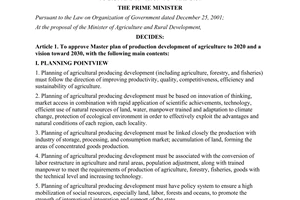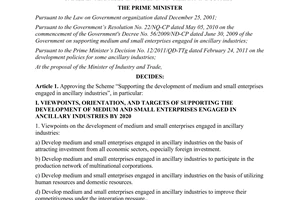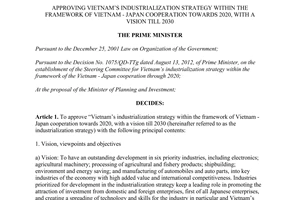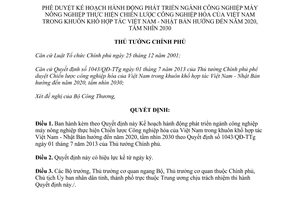Nội dung toàn văn Decision No. 1342/QD-TTg dated 2014 approving the plan to develop agricultural machinery industry 2020 2030
|
THE PRIME
MINISTER |
THE SOCIALIST
REPUBLIC OF VIETNAM |
|
No. 1342/QD-TTg |
Hanoi, August 12, 2014 |
DECISION
APPROVING THE PLAN OF ACTION TO DEVELOP AGRICULTURAL MACHINERY INDUSTRY IN IMPLEMENTATION OF VIETNAM’S INDUSTRIALIZATION STRATEGY WITHIN THE FRAMEWORK OF VIETNAM - JAPAN COOPERATION THROUGH 2020, WITH A VISION TOWARD 2030
THE PRIME MINISTER
Pursuant to the December 25, 2001 Law on Organization of the Government;
Pursuant to the Prime Minister’s Decision No. 1043/QD-TTg of July 1, 2013, approving Vietnam’s industrialization strategy within the framework of Vietnam - Japan cooperation through 2020, with a vision toward 2030; At the proposal of the Minister of Trade and Industry,
DECIDES:
Article 1. To promulgate together with this Decision the Plan of Action to develop agricultural machinery industry in implementation of Vietnam’s industrialization strategy within the framework of Vietnam - Japan cooperation through 2020, with a vision toward 2030, under the Prime Minister’s Decision No. 1043/QD-TTg of July 1, 2013.
Article 2. This Decision takes effect on the date of its signing.
Article 3. Ministers, heads of ministerial-level agencies, heads of government-attached agencies, chairpersons of provincial-level People’s Committees and related units and individuals shall implement this Decision.
|
|
PRIME MINISTER |
PLAN OF ACTION
TO DEVELOP AGRICULTURAL MACHINERY INDUSTRY IN IMPLEMENTATION
OF VIETNAM’S INDUSTRIALIZATION STRATEGY WITHIN THE FRAMEWORK OF VIETNAM-JAPAN
COOPERATION THROUGH 2020, WITH A VISION TOWARD 2030
(Promulgated together with the Prime Minister’s Decision No. 1342/QD-TTg of
August 12, 2014)
I. SITUATION
1. Position and role of agriculture, forestry and fisheries in Vietnam’s economic structure and their prospects toward 2020
In Vietnam’s economic structure, agriculture, forestry and fisheries made up 25% of GDP by 2000 and 21% by 2010. According to the 2011-2020 socio-economic development strategy, this proportion is expected to shrink to 15% by 2020. Nevertheless, since GDP itself has been growing well, the total output value of these sectors also increased to USD 78 billion in 2000 and USD 220 billion in 2010. By 2020, also according to the 2011-2020 socio- economic development strategy, to achieve the targets of per-capita GDP of USD 3,000 for a population of 96,400,000 and these sectors’ GDP proportion of 15%, their total output value must reach USD 430 billion (nearly doubled in 10 years).
The number of laborers in these sectors accounted for 65% of the total workforce in 2000 and 49% in 2010. According to the 10-year (2011-2020) socio-economic development strategy, this rate will be 30-35% by 2020.
2. Supply - demand analysis a/ 2020 forecasts
As forecast by the 2011-2020 socio-economic development strategy, the labor restructuring with a movement of the workforce from agriculture, forestry and fisheries or from rural areas to industry is foreseeable as a result of the process of industrialization in Vietnam. The total production output of agriculture also needs to increase for the reason that the population and food demand keep increasing. In addition, the maintenance and development of food export is considered a target which must be achieved. In order to continue reducing the number of laborers in agriculture, forestry and fisheries whilst scaling up their production, it is necessary to raise labor productivity in these sectors.
In that context, without special measures and policies, the said labor restructuring would apparently worsen the shortage of labor and aging of the labor force. Also, it will be more and more difficult to ensure the stable food supply for domestic consumption and export.
b/ Importance of mechanization in rice cultivation
If it is possible to produce more with fewer agricultural laborers, not only can agriculture be diversified, but also more time and labor can be saved for other non-agricultural activities, thus contributing to increasing incomes for farmers.
Laborers who become redundant due to improved labor productivity will move to urban centers. Once these laborers are employed by industrial and service sectors, such labor supply will be conducive to the development of these sectors.
To improve labor productivity in agriculture, the promotion of mechanization is quite necessary. In Japan, in order to raise agricultural productivity and improve the agricultural economy, the Act on Promotion of Agricultural Mechanization was enacted in 1953 and remains in force until now.
After 1996, Vietnam became the second largest rice exporter in the world, following Thailand. Some 20 countries are now importing rice from Vietnam. In 2013, Vietnam exported 6,587,074 tons of rice worth USD 2,922.681 million (an average of USD 443.7/ton). Moreover, rice accounted for around 30% of the total export value of sectors related to agriculture, forestry and fisheries and 4% of the country’s total export value. In addition, with rice growers accounting for over 80% of the total number of farmers, the wide mechanization in agriculture and development of the industry manufacturing agricultural machinery for rice cultivation and production would exert great effects on Vietnam.
This Plan of Action focuses principally on agricultural machinery for rice cultivation and production. Nonetheless, this model of mechanization, if successful, can be developed and applied to the cultivation and processing of other agricultural products such as sugar cane, maize, etc.
3. Existing problems of the market of agricultural machinery for rice cultivation and production in Vietnam
According to the national master plan on development of agriculture through 2020, with a vision toward 2030 (approved under the Prime Minister’s Decision No. 124/QD-TTg of February 2, 2012), the rates of mechanization in 2010 in the stages of soil preparation, sowing-planting- tending, harvest, and processing were 70%, 25%, 30% and 30%, respectively, and agricultural machines were not yet common.
This situation is attributable to:
- Small cultivation acreages (particularly in the Red River delta);
- Agricultural areas are scattered;
- Prices of agricultural machinery are still high compared to farmer incomes.
Regarding farmers’ purchase of agricultural machinery, though a number of support policies have been implemented to provide supports directly to farmers through the rural development bank, loan interest rate supports, technical training for farmers, local administrations’ supports or the Vietnam Farmers’ Association’s guarantee for farmers to borrow loans, results brought about by these policies remain low. Reasons for this situation include farmers’ tiny pockets for expensive agricultural machines (given the demand for these machines in localities), limited budgets of local administrations, complicated procedures and non-transparent use of support money in the course of implementation.
* Capacity of Vietnam-based manufacturers (including also foreign- invested enterprises) to meet the market demand:
As evaluated in the national master plan on development of agriculture through 2020, with a vision toward 2030, almost all manufacturers of tractors and agricultural machinery in Vietnam are small-sized, have a low output and closed manufacturing process and lack specialization and cooperation with one another in manufacture organization. Locally made agricultural mechanical products are largely small-capacity engines. Highly demanded agricultural machines such as trans-planters and harvesters cannot be manufactured at home yet and must be imported, including:
- 4, 6 and 8-row rice transplanters;
- Combined rice harvester-threshers with a cutting width of 1.6-2.2 meters;
- Four-wheeled tractors of a capacity of under 30 HP (for soil plowing and milling) and using multi-cylinder engines. To manufacture these tractors, Vietnam needs to cooperate with foreign countries, especially Japan, to improve its research and manufacturing capacity.
In addition, the capacity of domestic and foreign-invested enterprises in support industries to manufacture parts and accessories of the aforesaid agricultural machines is still weak and most of these enterprises are just small- or medium-sized ones. To promote the development of support industries in these enterprises, on October 17, 2012, the Prime Minister issued Decision No. 1556/QD-TTg approving the scheme to support the development of small- and medium-sized enterprises in support industries.
The market share of agricultural machinery by country shows that machinery imported from neighboring countries accounts for 60% while made-in-Vietnam products make up only 15-20%. The reason for this situation is that to enjoy a low import duty rate, these products have been illegally imported into Vietnam by declaring smaller quantities and lower prices. Vietnamese enterprises are condemning such illegal importation and demanding investigation as well as measures to handle it.
In regions with three rice crops a year and long-term use of agricultural machinery like the Mekong River delta, the use of high-durability Japanese combined machines has become more common in harvest as a new service. However, in other regions, sowers, transplanters, tractors and combined machines are still less popular.
Though factories assembling agricultural machinery may import machinery in complete units at the import duty rate of 0-10%, they must pay a 20% import duty for knocked down parts. Some hold that these irrational tax policies have limited the incentives for the purchase and manufacture of parts of agricultural machinery in localities.
II. ORIENTATIONS THROUGH 2020
To modernize Vietnam’s agriculture, promote agricultural machinery industry to serve the rice cultivation and production and increase the rice production productivity and contribute to raising incomes for farmers.
III. TARGETS SET FOR 2020
1. Total output of agriculture
From the total value of USD 220 billion actually achieved in 2010 to the target of USD 430 billion by 2020.
(Note: The 10-year plan sets the target that by 2020 the per-capita income will reach USD 3,000, and agriculture’s GDP proportion of 15% will be necessary for achieving such target. The total amount is in US dollars at present time based on practical calculations. Amounts below are similarly calculated).
2. Higher labor productivity
From the level of USD 740/person actually achieved in 2010 to the target of USD 2,000/person by 2020.
(Note: The agricultural population in the 10-year plan has been adjusted).
3. Rate of agricultural mechanization
By 2020, this rate at the stages of soil preparation, sowing-planting- tending, harvest and processing will reach 95%, 70%, 70% and 80%, respectively.
IV. STRATEGIC ISSUES
1. To encourage farmers to use agricultural machinery (the demand side);
2. To encourage manufacturers to supply agricultural machinery based on farmers’ demand (the supply side);
3. To elaborate regulations to create a healthy environment for agricultural machinery trading (the market side).
V. PLAN OF ACTION
1. To implement the program to support the supply of quality agricultural machinery to farmers (the demand side)
|
|
Plan of action |
Implementatio n period |
Implementing agency |
Coordinating agency |
|
1 |
Surveying the actual situation and results of agricultural mechanization and support policies in a number of localities |
July - December 2014 |
Ministry of Agriculture and Rural Development |
Ministry of Finance, Ministry of Industry and Trade |
|
2 |
Referring to Japan’s Act on Promotion of Agricultural Mechanization to draft a Prime Minister decision on promotion of agricultural mechanization, covering also contents 2.1 thru 2.4 below, to be approved by the Prime Minister |
January - June 2015 |
Ministry of Agriculture and Rural Development |
Ministry of Finance, Ministry of Industry and Trade |
|
2.1 |
Identifying the State’s basic orientations to promote agricultural mechanization in each locality |
January - June 2015 |
Ministry of Agriculture and Rural Development |
Ministry of Finance, Ministry of Industry and Trade |
|
2.2 |
Based on the State’s basic orientations, funding sources and characteristics of localities, local administrations take the initiative in working out plans of action to promote agricultural mechanization in their localities |
May - December 2015 |
Provincial- level People’s Committees |
Related ministries and sectors |
|
2.3 |
Implementing plans on action to promote agricultural mechanization worked out by localities |
2016 - 2020 |
Provincial- level People’s Committees |
Related ministries and sectors |
|
2.4 |
The State considers and provides part of the budget necessary for implementation of approved local plans of action |
2016 - 2020 |
Ministry of Finance |
Ministry of Planning and Investment, Ministry of Industry and Trade, Ministry of Agriculture and Rural Development |
2. To encourage manufacturers to supply agricultural machinery for rice cultivation and production based on farmers’ demand (the supply side)
|
|
Plan of action |
Implementation period |
Implementing agency |
Coordinating agency |
|
1 |
Organizing exhibitions of agricultural machinery and showing steps of operating such machinery to local farmers nationwide, with assistance of domestic and foreign manufacturers |
July – December 2014 |
Ministry of Industry and Trade |
Ministry of Agriculture and Rural Development |
|
2 |
Supporting the organization of training workshops and conferences by domestic and foreign agricultural machinery manufacturers |
July – December 2014 |
Ministry of Industry and Trade |
Ministry of Agriculture and Rural Development |
|
3 |
Elaborating and promulgating standards and technical regulations on agricultural machinery for rice production |
2014 - 2020 |
Ministry of Agriculture and Rural Development |
Ministry of Industry and Trade |
|
4 |
Encouraging manufacturers in Vietnam to supply agricultural machinery for rice cultivation and production to meet farmers’ demand |
2014 - 2020 |
Ministry of Industry and Trade |
Ministry of Agriculture and Rural Development |
|
5 |
Supplementing and completing tax regulations so that factories assembling agricultural machinery may purchase some domestically manufactured parts |
2014 - 2020 |
Ministry of Finance |
|
3. Elaborating regulations to create a healthy environment for agricultural machinery trading (the market side)
|
|
Plan of action |
Implementation period |
Implementing agency |
Coordinating agency |
|
1 |
Conducting annual market surveys based on the three targets set in the Section “Targets set for 2020” and other relevant targets, and announcing results |
2014 - 2020 |
Ministry of Agriculture and Rural Development |
Ministry of Industry and Trade |
|
2 |
Building the capacity (equipment and training) of experimentation laboratories and centers for quality inspection of agricultural machinery |
2014 - 2020 |
Ministry of Agriculture and Rural Development |
Ministry of Industry and Trade |
|
3 |
Conducting surveys of illegal agricultural machinery found in the country. Survey contents include: - From the viewpoint of protection of consumer interests, gathering data on goods lacking certain utility functions specified in the list of goods; - From the viewpoint of fair tax policies, gathering data on goods imported as scraps - From the viewpoint of suppression of unhealthy competition, gathering data on goods infringing upon trademarks - From the viewpoint of safety for farmers, gathering data on dangerous goods likely to be unsafe for humans and the environment |
2014 - 2020 |
Department of Market Management, Department of Competition Management, Department of Techniques and Safety - the Ministry of Industry and Trade |
Ministry of Agriculture and Rural Development, General Department of Taxation - the Ministry of Finance, Ministry of Public Security |
|
4 |
Based on results of the above two sections, proposing solutions and handling policies |
2014 - 2020 |
Ministry of Industry and Trade |
Ministry of Agriculture and Rural Development, General Department of Taxation - the Ministry of Finance, Ministry of Public Security |
VI. ORGANIZATION OF IMPLEMENTATION AND SUPERVISION MECHANISM
1. Organization of implementation
- The Ministry of Industry and Trade shall:
+ Base itself on the Plan of Action to organize and assign agencies, organizations and enterprises under its management to implement contents of the Plan;
+ Urge and inspect ministries, sectors and localities in implementing the Plan of Action; annually conduct surveys and review and report on the implementation of the Plan to the Steering Committee for the Industrialization Strategy; preliminarily and finally review and evaluate results and efficiency of the implementation of the Plan of Action, and report them to the Prime Minister.
- The Ministry of Planning and Investment and Ministry of Finance shall:
+ Assume the prime responsibility for implementing solutions regarding funding sources;
+ Balance and incorporate funds for implementation of the Plan of Action in annual budget estimates of central agencies and budget supports for localities in accordance with law.
- Related ministries, sectors and localities shall:
+ Elaborate and implement specific contents of the Plan of Action;
+ Review and evaluate results and efficiency of implementation of the Plan of Action.
- Funds for implementation of the Plan of Action shall be raised from the central budget, local budgets, international aid, contributions of the society and community and other lawful sources.
2. Supervision of implementation of the Plan of Action
The Ministry of Industry and Trade shall supervise the implementation of the Plan of Action and report it at meetings of the Working Group for the Industrialization Strategy once a year. The Working Group shall report supervision results to the Steering Committee for the Industrialization Strategy.
3. Adjustment of the Plan of Action
The Ministry of Industry and Trade shall coordinate with the Working Group for the Industrialization Strategy and related ministries and sectors in reviewing and evaluating implementation results by 2015 as well as appropriate experience of the Japanese side, and base itself on such results and experience to adjust contents of the Plan of Action which need to be implemented from 2016.
|
|
PRIME MINISTER |




